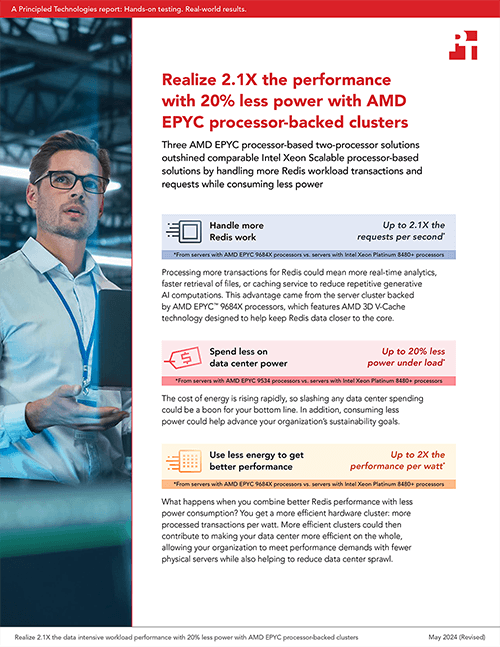
Redis in-memory data store solutions can provide a level of high-speed caching that works especially well with highly responsive data-intensive applications such as online transaction processing systems, mobile games, and booming services such as generative AI. In a market where millisecond lags can add up to choppy service and dissatisfied customers, investments in data center CPU upgrades could pay off by boosting Redis performance. But higher costs—including higher power bills—can often accompany higher performance. Companies that are considering CPU upgrades for their servers need hardware that can handle growing processor performance demands in a cost- and energy-efficient way.
We compared the Redis performance and energy consumption of a server cluster in three AMD EPYC processor-based configurations against those of a server cluster in two Intel Xeon Scalable processor-based configurations. We used three test scenarios to compare the clusters: 1) clusters with the closest possible core counts; 2) clusters with processors that typically have similar retail prices; and 3) clusters with processors that have the same number of cores.
In each of the three test scenarios, the AMD EPYC processor-based cluster supported better performance than its Intel Xeon Scalable processor-based counterpart—up to 2.1 times the requests per second. In addition, in two of the three scenarios, the EPYC-based cluster consumed less power (up to 20 percent fewer watts) while achieving better performance.
Combining these measurements gave us power efficiency metrics that demonstrate how AMD EPYC processor-based servers can provide both performance gains and ongoing value. With these AMD EPYC-based clusters, organizations could see better performance per watt and potentially get more from their Redis or other data-intensive workloads—all while reducing data center power costs.
For more details about our AMD EPYC-based and Intel Xeon Scalable-based cluster comparison tests, check out the report below.
Principled Technologies is more than a name: Those two words power all we do. Our principles are our north star, determining the way we work with you, treat our staff, and run our business. And in every area, technologies drive our business, inspire us to innovate, and remind us that new approaches are always possible.






